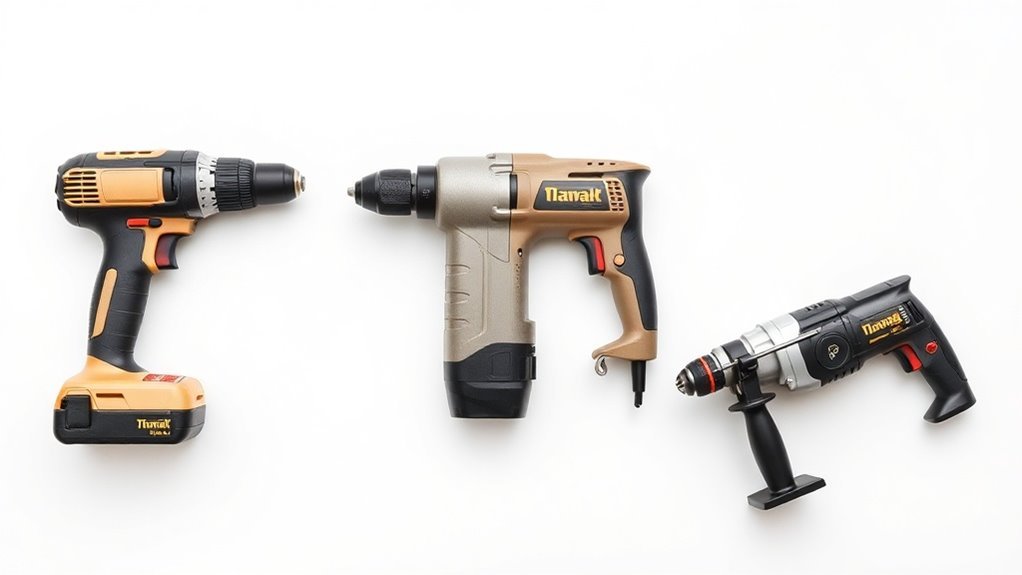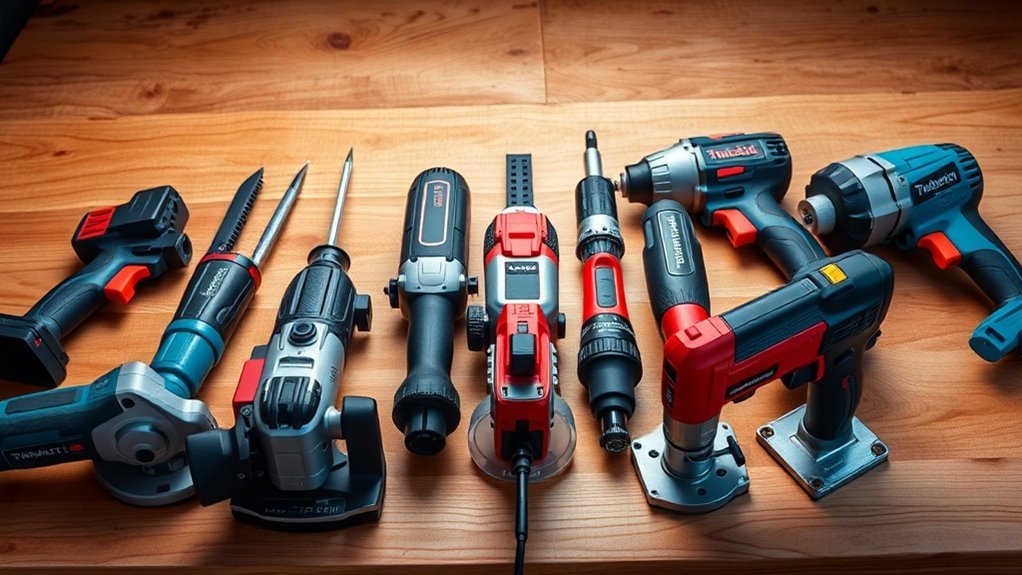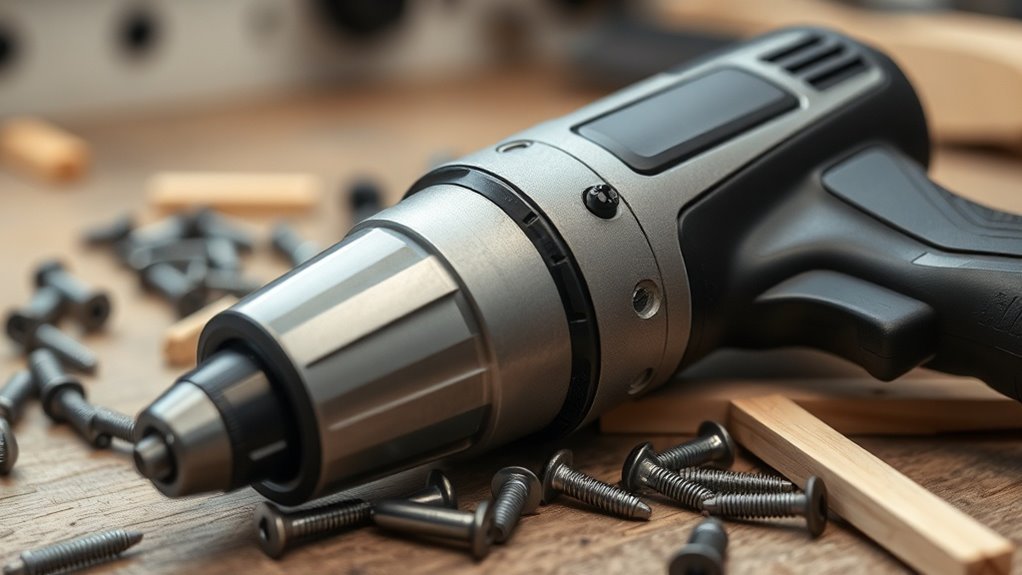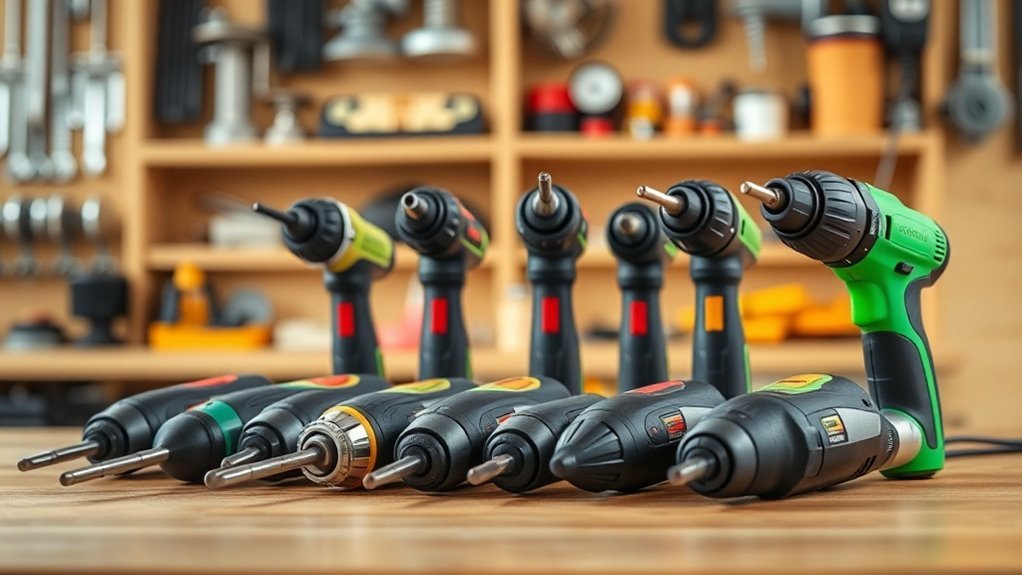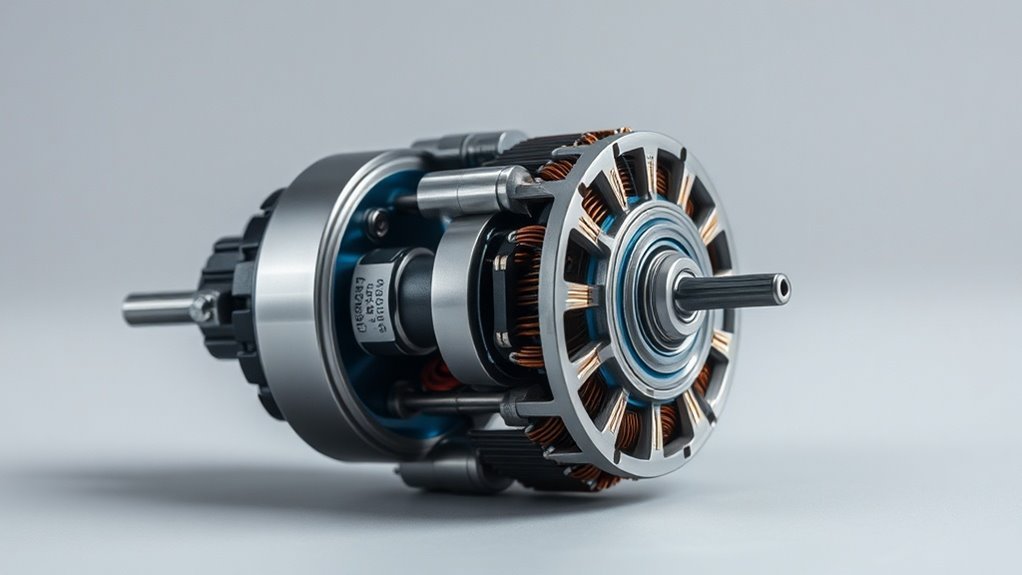Safety Rules Every Beginner Should Follow With Power Tools
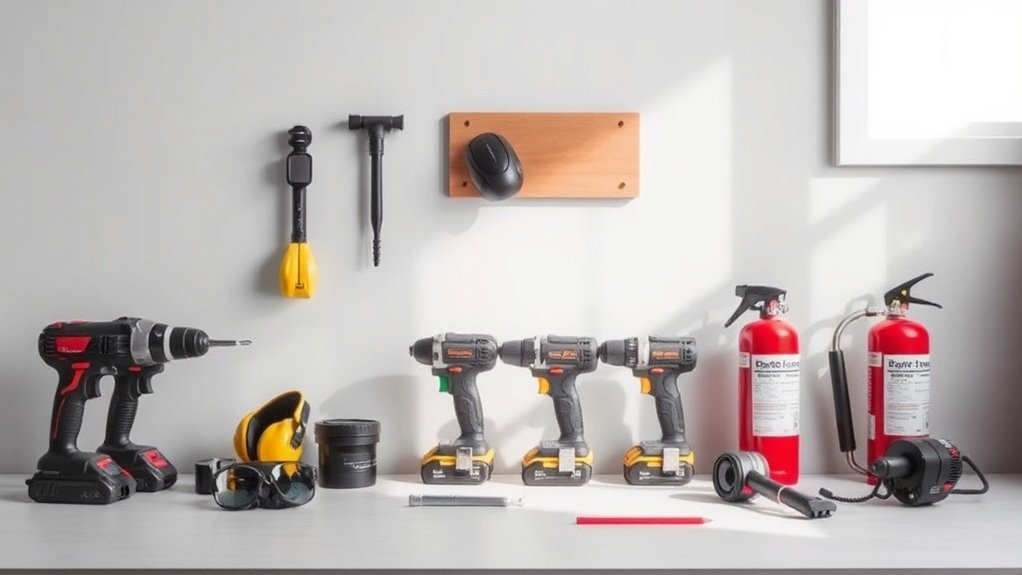
When using power tools, it’s essential to understand the tools you’re working with and wear the right protective gear, like safety glasses and gloves. Keep your workspace clean and organized to avoid accidents, and always follow the manufacturer’s instructions. Before each use, inspect your tools for damage, maintain a safe distance from others, and make sure you’re using the appropriate tool for the job. There’s more to safety than just these basics, so let’s explore further.
Key Takeaways
- Always wear appropriate personal protective equipment, such as safety glasses and gloves, to safeguard against potential injuries.
- Familiarize yourself with tool features and safety guidelines outlined in the user manual before use.
- Maintain a clean and organized workspace to minimize distractions and prevent accidents.
- Ensure proper handling of tools by practicing safe techniques and using the right tool for each specific task.
- Stay aware of your surroundings, keeping bystanders and pets at a safe distance while operating power tools.
Understand the Tools You Are Using
Before you plunge into using any power tool, it’s important to fully understand what you’re working with. Take the time to read the user manual and familiarize yourself with the tool’s specific functions and features.
Know the difference between cordless and corded options, as well as the various attachments or accessories that might be available. Practice handling the tool while it’s unplugged, ensuring you understand its weight and balance.
Understand the distinctions between cordless and corded tools, and practice handling them to grasp their weight and balance.
You should also recognize the intended applications for each tool, so you don’t misuse them. If you’re unsure about any features, don’t hesitate to ask a more experienced user for help. Understanding the differences between cordless and corded drills helps prevent accidents and improves your overall efficiency, leading to better results in your projects.
Wear Appropriate Personal Protective Equipment

Power tools can be exhilarating to use, but safety should always come first, starting with wearing appropriate personal protective equipment (PPE).
Before you start any project, put on safety glasses to protect your eyes from flying debris. Hearing protection is essential too—consider earmuffs or earplugs when using loud tools.
Don’t forget gloves to shield your hands from sharp edges and hot surfaces. A dust mask can keep harmful particles out of your lungs, especially when cutting or sanding materials.
Finally, closed-toed shoes with non-slip soles will help protect your feet and provide stability. Additionally, using essential safety gear like respirators when dealing with chemicals can further enhance your protection.
Keep Your Work Area Clean and Organized
A cluttered workspace can lead to accidents and mistakes when using power tools. Keeping your work area clean and organized is crucial for ensuring safety and efficiency.
A tidy workspace is essential for safety and efficiency when using power tools.
By maintaining a tidy space, you’ll be less distracted and more focused on your tasks.
Here are some tips to help you keep your workspace in order:
- Clear away any debris: Dispose of scraps, sawdust, and other waste immediately.
- Store tools properly: Use designated storage for each tool, preventing trips and falls.
- Designate a workspace: Create a specific area for your projects, separate from other spaces.
- Keep frequently used items within reach: This minimizes unnecessary movement and distractions.
Additionally, consider implementing ergonomic principles for your tool placement to enhance safety and accessibility.
Follow Manufacturer Instructions and Guidelines
One of the most important steps in using power tools safely is following the manufacturer’s instructions and guidelines. These documents provide critical information about the proper use, maintenance, and safety features of your tools. By reading them carefully, you’ll understand how to operate the tool effectively while minimizing risks.
Don’t skip this step; it might seem tedious, but it’s essential for preventing accidents.
Make sure to familiarize yourself with the tool’s parts, safety mechanisms, and ideal operational techniques. If the guidelines include protective equipment recommendations or specific safety precautions, take them seriously.
Ignoring these instructions can lead to unexpected dangers. Always refer back to them, especially when using a tool for the first time or after a long break. Your safety depends on it! Furthermore, using proper tools like circuit testers can enhance your overall understanding of electrical systems and safety.
Inspect Tools Before Use
Before you start using any power tool, it’s essential to inspect it for damaged parts. A quick check can prevent accidents and guarantee everything’s functioning properly. Make sure to also examine any extension cords you may use for fraying or damage, as these can pose additional safety risks. Don’t skip this step—your safety depends on it.
Check for Damaged Parts
Inspecting your tools for damaged parts shouldn’t be overlooked—it’s an essential step for guaranteeing safety.
Before you start working, take a moment to examine your power tools closely. You never know what issues might be lurking that can lead to accidents or injuries.
Here are some key points to check:
- Wires and Cords: Look for frays, cuts, or exposed wires.
- Blades and Bits: Inspect for nicks, cracks, or dullness that could impair performance.
- Housings: Confirm there are no cracks or breaks in the tool’s casing.
- Switches and Controls: Verify they operate smoothly and aren’t sticking.
Ensure Proper Functionality
As you prepare to use your power tools, verifying they’re functioning correctly is essential for your safety and the success of your project.
Start by inspecting each tool before use; look for any faulty components or signs of wear. Check the power cord for frays, verify plugs are intact, and confirm blades or bits are sharp and secure.
If you’re using a battery-operated tool, make sure the battery is charged and properly seated. Also, test the switch to see if it responds as expected.
Taking these simple steps doesn’t just prevent accidents, it also helps avoid frustrating delays. When you’ve confirmed everything’s in working order, you’ll feel confident to proceed, knowing you’ve prioritized both safety and effectiveness.
Maintain a Safe Distance From Others
When using power tools, it’s crucial to maintain a safe distance from others to prevent accidents. Having people too close to your work area can lead to injuries or distractions.
Maintaining a safe distance while using power tools is essential to avoid accidents and distractions.
Make sure to establish a clear boundary around your workspace where others aren’t allowed. This helps everyone stay safe and focused.
- Always communicate your intentions when using tools.
- Use barriers or cones to mark your workspace.
- Keep bystanders, especially children and pets, at least 10 feet away.
- Encourage others to wait until you’re finished before approaching.
Additionally, wearing personal protective equipment (PPE) is essential for maintaining safety in your workspace.
Always Use the Right Tool for the Job
Using the right tool for the job isn’t just a matter of efficiency; it’s crucial for your safety. When you choose the appropriate tool, you reduce the risk of injury and guarantee better results.
Each tool is designed for specific tasks, and using them correctly helps prevent dangerous accidents. For instance, don’t try to cut wood with a metal saw; it’s not safe and won’t work well.
Always read the instructions and familiarize yourself with how each tool operates before using it. If you’re unsure about which tool to use, don’t hesitate to ask someone more experienced.
Know Emergency Procedures and First Aid Basics
When you’re working with power tools, knowing what to do in an emergency is essential.
Make certain you identify your emergency contacts and have basic first aid skills to handle potential injuries.
Don’t forget to prepare a first aid kit to guarantee you’re ready for anything that might happen.
Identify Emergency Contacts
How prepared are you for an emergency while working with power tools? It’s vital to have a plan in place.
First, know who to contact in case of an accident, as this can make all the difference.
Consider having the following details accessible:
- Local emergency services number: Make sure it’s saved in your phone.
- Workplace supervisor: They need to be informed of any incidents quickly.
- First Aid personnel: Identify who’s trained in your workspace.
- Family or friends: Let them know you’re working with tools and how to reach you.
Being proactive about your emergency contacts can help prevent panic and guarantee a swift response when you need it most.
Learn Basic First Aid
Understanding basic first aid is vital for anyone working with power tools. Accidents can happen, and knowing how to respond quickly can make all the difference.
Familiarize yourself with common injuries like cuts, burns, or bruises and how to handle them effectively. For minor cuts, clean the area with water and apply a sterile bandage. If you encounter burns, cool the area under running water and cover it with a clean cloth.
It’s also important to know when to seek professional medical help. For serious injuries or if someone’s unconscious, don’t hesitate to call emergency services.
Taking a first aid course can boost your confidence and prepare you for unexpected situations, ensuring you’re ready to act when necessary.
Prepare a First Aid Kit
While having the right tools is essential for any DIY project, equally important is being prepared for emergencies with a well-stocked first aid kit. You never know when an accident might occur, so take a moment to gather essential items that can help in a pinch.
Make certain your kit includes:
- Adhesive bandages in various sizes
- Sterile gauze pads and tape
- Antiseptic wipes or solution
- Personal medications and allergy treatments
Regularly check your kit to verify supplies are up-to-date and replace any used items.
Familiarize yourself with basic first aid procedures so you can respond quickly if an accident happens. Staying prepared means you can tackle your projects with confidence, knowing you’re ready for anything!
Questions
What Types of Personal Protective Equipment Are Most Essential for Beginners?
The most essential personal protective equipment for beginners includes safety goggles, ear protection, gloves, and dust masks. These items safeguard you against injuries and harmful substances while working with various tools and materials. Always wear them!
How Can I Minimize Noise Exposure When Using Power Tools?
To minimize noise exposure when using power tools, consider using earplugs or earmuffs, choosing quieter equipment, and creating calm conditions. Consciously controlling your surroundings helps dramatically diminish disruptive decibels while you work.
Are There Any Specific Tools That Are Safer for Beginners?
Yes, tools like electric screwdrivers, cordless drills, and orbital sanders are generally safer for beginners. They’re easier to control, reduce kickback risks, and have safety features that help you work confidently and efficiently.
How Should I Store Power Tools to Ensure Safety?
Imagine your new drill neatly stored in a dedicated toolbox. Keep power tools in a secured, dry place, away from kids, and make certain they’re unplugged or the batteries are removed to prevent accidental starts.
What Common Mistakes Do Beginners Make With Power Tools?
Beginners often underestimate tool complexity, neglect proper maintenance, or rush tasks. They might skip protective gear, misjudge cuts, or ignore instructions. It’s essential to take your time and prioritize safety to avoid costly mistakes.
Conclusion
In summary, by sticking to these safety rules, you’re setting yourself up for success while minimizing risks. Did you know that nearly 400,000 injuries related to power tools occur in the U.S. each year? That’s a staggering number! So, whether you’re a novice or just brushing up on your skills, always prioritize safety. Being informed and cautious not only protects you but guarantees a productive and enjoyable experience with power tools. Stay safe and happy crafting!


